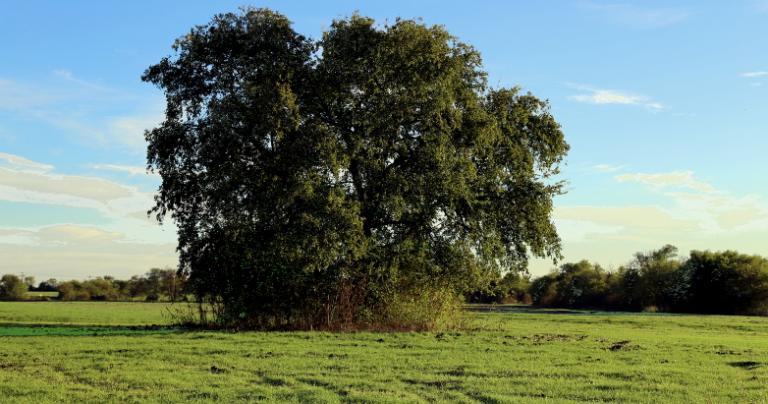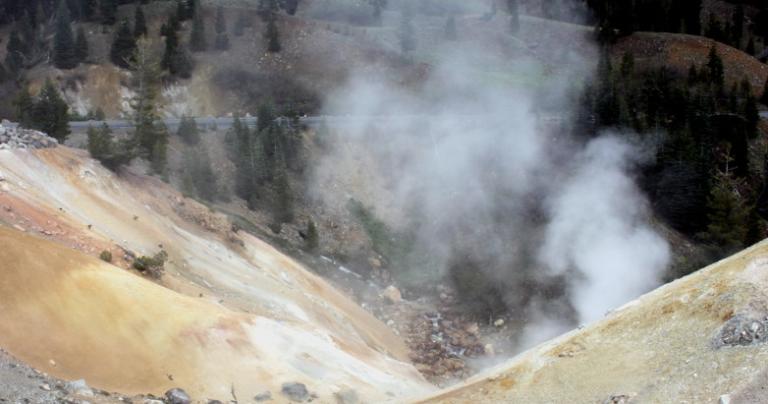Last week author and podcaster Devin Hunter talked about heaven and hell on his Facebook page, and he asked whether or not they had a place in a book on witchcraft. They’re part of his worldview: not in the Christian sense but in the sense of “the Overworld and the Underworld.”
I don’t like the terms heaven and hell, because using Christian terms reinforces Christian assumptions. Some witches and occultists are fine working in a Christian worldview. That’s their business. I’m a Pagan and a polytheist – I had to make a clean break with Christianity. I don’t just do magic, I do religion.
I said all I need to say on that topic in the two posts linked to in the paragraph above. But the question and Devin’s elaboration made me realize it’s not just heaven and hell I don’t believe in, it’s the whole concept of an Upper World, Middle World, and Lower World.
The three realms of Druidry are not the same thing
Both ADF and OBOD teach the three realms of land, sea, and sky. It’s a Celtic way of viewing the world, as opposed to dividing the world into four elements like the Western Mystery Tradition (OBOD teaches the four elements in addition to the three realms – ADF does not). The Anglesey Druid Order takes the concept a step further and structures their mythological, liturgical, deific practices around the three realms.
We can see and touch the land, the sea, and the sky – the three realms obviously exist in this world. It is not a much of a stretch to assume they also exist in the world of spirit, an assumption supported by the stories of our ancestors and by our own first-hand experiences.
But three realms within one world is one thing. Three worlds is something very different.
Sky Gods and the Underworld
The idea of an underworld is so old it’s fair to call it primal. Our species has always buried its dead, and it is almost certain Neanderthals did as well, in caves if not in the ground. Some cave paintings are over 30,000 years old. Most of them are so deep in the caves it takes great effort to reach them – they were clearly more than mere decorations. The idea of an underworld as the land of the dead is both old and intuitive.
Much has been written about the triumph of the Sky Gods over the Earth Goddesses in the early Neolithic. How much of that is historical and how much is speculation is another topic for another time. What’s important for us is that there are Sky Gods… and Goddesses. Sometimes They live on mountains, sometimes in the clouds, and sometimes in the stars. The idea of an upper world as the land of the Gods is also both old and intuitive.
And if that’s all there was, I would never have written this post. But there’s more.
The three worlds and core shamanism
When I google “upper world middle world lower world” every site on the first page deals with shamanism. Not Siberian shamanism (where the term originated) or the shamanism of various tribal peoples (who have their own terms for practices that are similar but not identical) but just “shamanism.” And that’s our first clue.
Much of the talk of the three worlds in modern Paganism comes from Michael Harner and his “core shamanism” – the attempt to distill the techniques of shamanic practices from the cultures that supported them.
Authentic shamanism is practiced within a specific culture. Divorced from that culture its practices are rootless and while they still have some effectiveness, they can never be what they are when practiced within their original context.
In any case, core shamanism is built on the three worlds model. It says that we live in the Middle World and by using shamanic techniques we can journey to the Upper World or to the Lower World. A few cultures do have a three worlds model, or something like it.
Many more do not. That doesn’t prove the model is wrong, but it does show that the model is not as universal as Harner and his followers claim. That makes the model very suspect from the beginning.
Religion and magic are not psychology
Psychology is a wonderful science and art that has done much good for humanity over the past 130 years or so. It has helped us to do a better job of understanding both religion and magic – my model of magic includes a psychological element. But psychology is no substitute for religion or magic.
We’re all familiar with Sigmund Freud’s concept of id, ego, and superego. The Feri Tradition has their concept of the Triple Soul: the talker, the fetch, and the god-soul (which, to be clear, includes psychological concepts but is more than psychology). In some of my early magical training I was taught that we do ritual because it speaks in symbols to our subconscious, which subtly tells our conscious self what to do.
So when we begin journeying – especially when we are unsure if we’re actually traveling to different worlds or if we’re exploring different aspects of our own consciousness – we’re often instructed to visit the “upper world” where our highest virtues and our “better angels” reside. We’re told to visit the “lower world” where our fears and wounds lie hidden along with our “demons.” Then we’re told to bring back wisdom from the upper and lower worlds and integrate it into our waking lives here in the “middle world.”
I want to be very clear: these are valid concepts and helpful practices. For many of us they are a necessary place to begin a spiritual journey. Psychology is a wonderful science and art.
But too many Pagans build their whole religion on psychology, because they’re stuck in a materialist worldview – the philosophical assumption that all that exists is matter and the products of its interactions. They stretch the psychological concepts of the upper world, middle world, and lower world into actual places.
And then, sometimes, they label them with names of places in other religions – like heaven and hell.
The Otherworld: the land of the Gods and ancestors
In my model of reality there is this world and there is the Otherworld: the world of the Gods and ancestors. Perhaps it would be better to describe the Otherworld as the world of spirits. Gods are simply the mightiest of spirits, and I see the various spiritual beings existing on a continuum rather than in discreet categories.
Like this world, the Otherworld has many different locations and realms. The Egyptian Duat is different from the Greek Olympus… and from the Greek Tartarus. I see no reason to accept one culture’s visions of the afterlife and reject others, except to look very skeptically at any claims to exclusivity and universality. The Otherworld may very well include places that look a lot like the commonly held views of the Upper World and the Lower World. But these are simply two locations out of many.
As with my thoughts about death and the afterlife, I hold these beliefs very loosely. There’s lots of evidence surrounding the Otherworld (in the stories of our ancestors and in our own first-hand experiences) but there is no proof. I wonder about these things as they come to me and I treasure my experiences of them, but my primary concern is living this life while I’m here.
Still, I need a model to understand the universe and my place in it. My model has two worlds, not three.
Why this matters
I think in public. I write and talk about my thoughts in part because I’m trying to refine my beliefs and practices and blogging lets people try to poke holes in them. I’m not afraid of criticism – if my thoughts are strong they’ll hold up. If they crack under pressure then I need to re-evaluate them.
All our thinking is grounded in foundational assumptions. It’s supported by cultural expressions and practices.
I’m a Pagan and a polytheist. My Paganism and my polytheism are grounded in animism, in our ancestors, in religious experiences, and in the relationships I form with various human and other-than-human persons.
This foundation is very different from the assumptions of psychology, of Christianity, and of core shamanism. I want to support my own Pagan and polytheist foundations, not the foundations of other traditions.
The three worlds model of the universe is popular because if flows out of traditions that are common in our mainstream culture. It isn’t completely wrong – it has value in a psychological context.
But when we examine the beliefs and practices of our ancient ancestors, and when we begin to journey outside our own heads, we start to see that the three worlds model is inadequate to describe reality as we experience it.
And so despite its popularity in contemporary Paganism, I don’t believe in the three worlds. Instead, I believe in this world and in an immensely large Otherworld.





















